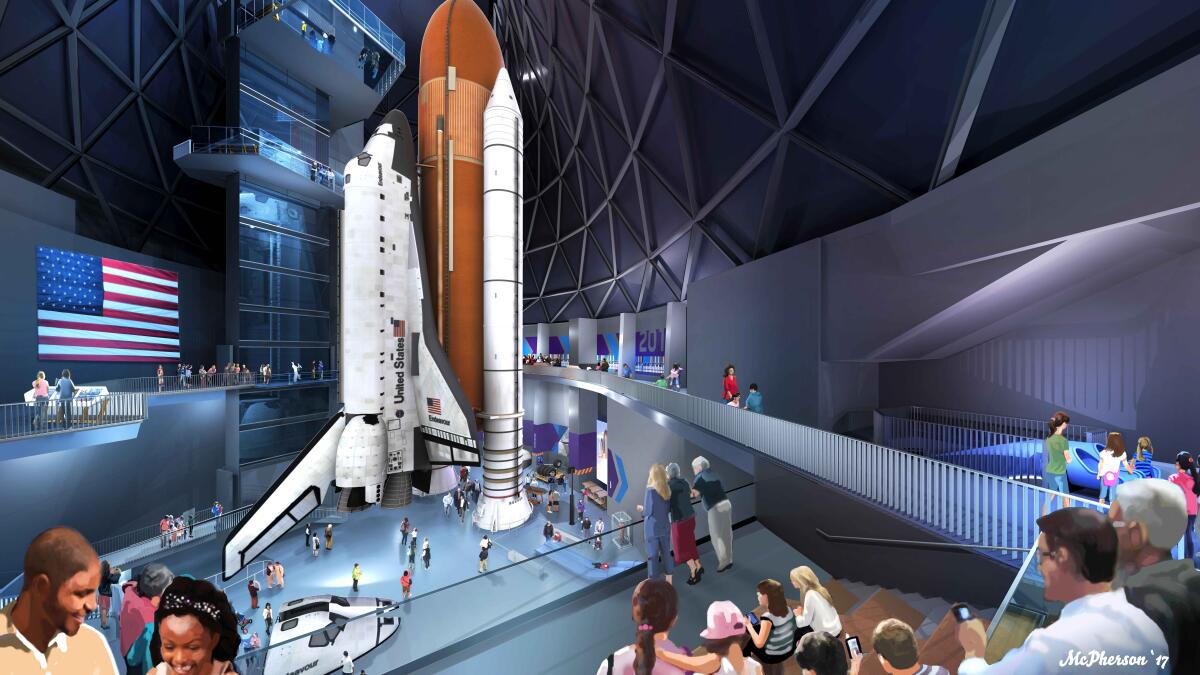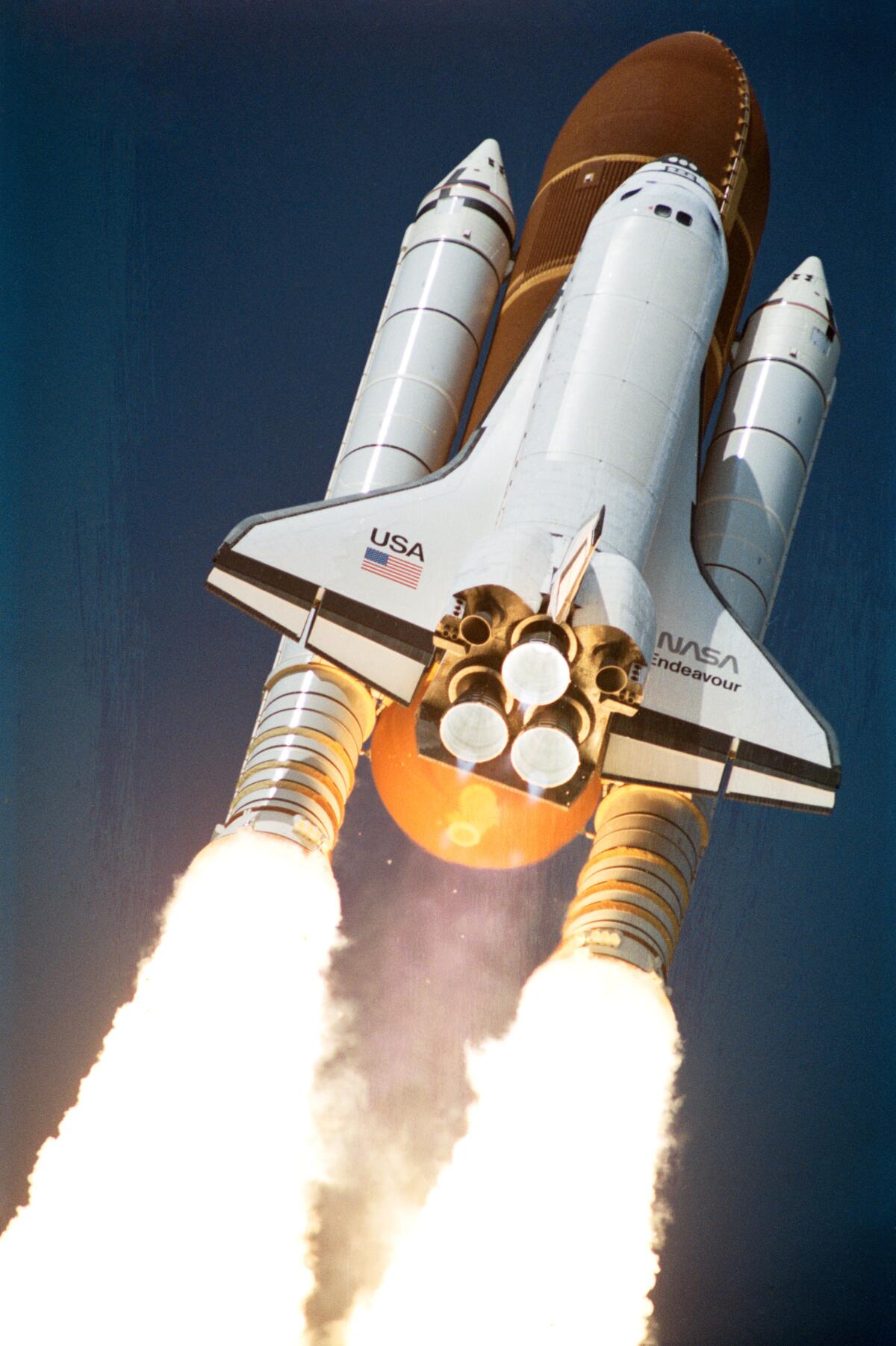Get ready for the last major transport of Space Shuttle equipment to the California Science Center. A two-day spectacle that will cross seven freeways from the Mojave Desert to South Los Angeles, where he will eventually be installed in a grand 20-story museum exhibit.
This is the last major piece of equipment needed as the California Science Center builds the Samuel Oshin Aerospace Center, the final museum home for the Space Shuttle Endeavor, as it prepares for launch. It is assembled like this. Construction of the new museum building has been anticipated since 2011, when NASA selected the science center to be one of only three museums in the United States to permanently display the three existing shuttles that have experienced spaceflight.
When the final exhibit is fully completed, Endeavor will be the only space shuttle on display as if it were ready for launch. Endeavor is expected to be removed from its temporary hangar and hoisted from a horizontal position to a vertical position by the last week of January.
This week’s Space Shuttle equipment move will take three hours on Tuesday morning and six hours on Wednesday morning. This movement involves the twin solid rocket motors that make up most of the white solid rocket boosters. The solid rocket booster generated more than 80% of the lift during takeoff.
The rocket motor will travel about 260 miles from its current base at Mojave Air and Space Port to the California Science Center.

A rendering of the Space Shuttle Endeavor, which will appear at the new Samuel Oshin Aerospace Center when completed.
(Ron McPherson/California Science Center Foundation)
Each solid rocket motor donated by Northrup Grumman is large, measuring 12 feet, 2 inches in diameter and 116 feet long. Each solid rocket motor weighs 104,000 pounds and each is transported by one truck.
“Those are big rockets,” said Jeffrey Rudolph, director of the California Science Center. “And they’re about the diameter.” [Boeing] It’s about the same length as the 757’s fuselage. That’s why they are quite large to move on the street.
“This is really the last big part of the ‘vertical rise’ that the public will be able to come out and see and participate in.” “It’s an opportunity,” he said.
The solid rocket motor is wide enough to drive in multiple lanes.
But the rocket motor’s diameter is small enough that if carried in a low truck bed, it could fit under a highway underpass along a designated route. This means that transporting this equipment will be much easier and faster than transporting the 2012 Endeavor orbiter or his 2016 orange external tank.
Highways do not require road closures for movement. Instead, the plan is to surround the solid rocket motor with escort vehicles and California Highway Patrol vehicles. Rocket motor speeds are typically 45 mph on the highway.

Solid rocket boosters (two white rockets) under Endeavor’s wings provided most of the lift to propel the space shuttle into orbit.
The rocket motor will depart Mojave Air and Space Port at 9 a.m. Tuesday, exiting south on Airport Road and east on Mojave-Barstow Highway to Route 58.
Rocket Motor then heads south on Route 395 and then south on Interstate 15 through Cajon Pass. Once in Rancho Cucamonga, Rocket Motor will head west on the 210 Freeway to Irwindale, where it will continue south on the 605 Freeway, arriving somewhere around noon Tuesday. The rocket motor will be placed on the side of the highway for about 15 hours. It did not impede traffic and its exact location was not disclosed.
The journey will then resume at 3am on Wednesday. Rocket Motor heads south on Highway 605. After arriving in Norwalk, Lockett said he headed west on Route 105, then turned north on Route 110, exiting at about 5 a.m. on Gage Avenue and heading east, then north on Broadway.
The Rocket Motors then turns left onto Slauson Avenue, passes under Highway 110, and turns right onto Figueroa Street. At 7:30 a.m., the rocket motor will depart from West 43rd Street and head north on Figueroa Street, traveling about three miles before arriving at the California Science Center.
Rocket Motor is scheduled to stop at 8 a.m. at Figueroa Avenue and Martin Luther King Jr. Boulevard. They are scheduled to cross the ceremonial finish line at Figueroa and 39th Street at 8:45 a.m., then turn left onto State Drive at 9 a.m., eventually arriving at the California Science Center.
“People can come out and be on the sidewalk and watch,” Rudolph said. The public is invited to gather along Figueroa Street from West 43rd Street to 39th Street, the museum said. The California Science Center will also open an hour earlier at 9 a.m. on Wednesday, allowing spectators to enter as soon as the solid rocket motors arrive.
The closest subway station to the California Science Center is the Expo Park/USC station on the “E” light rail line, formerly known as the Expo Line. Parking is also available in the museum’s blue lot, but you must enter through the Hoover Street and Martin Luther King Jr. Boulevard entrances.
Once Rocket Motor exits Highway 110, there will be phased closures on city streets.
Since Endeavor arrived in 2012, the orbiter has been on display in the temporary Samuel Oshin Pavilion, essentially a warehouse where it has been on display for the past decade, and will remain on display until Dec. 31. That is scheduled. Years before museum visitors were able to see Endeavor up close again.
In mid-2022, the California Science Center broke ground on its new permanent museum, and construction crews began installing the base of the shuttle’s full stack three months ago. They installed the lower section of the 9-foot-long solid rocket booster known as the Aftskirt, which will support the solid rocket motor that will be shipped across Southern California this week.
Once the solid rocket motor is installed, the 27-foot-tall “forward assembly,” which includes the rocket’s tip, nose cone and forward skirt, is next installed. When fully assembled, the solid rocket boosters will be approximately 149 feet long and each weigh approximately 130,000 pounds.
This will allow for the orange external tank to be ready for installation by early January, followed by Endeavor.
